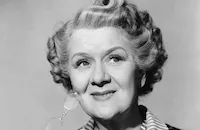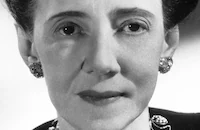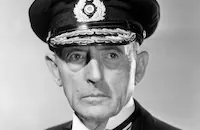Ever in My Heart

Brief Synopsis
Cast & Crew
Archie Mayo
Barbara Stanwyck
Otto Kruger
Ralph Bellamy
Ruth Donnelly
Laura Hope Crews
Film Details
Technical Specs

Synopsis
Mary Archer expects to marry her cousin Jeff when he comes home from studying in Europe in 1909, but when she meets his German friend, Hugo Wilbrandt, she falls hopelessly in love. Despite her family's opposition, the two are married and Hugo takes a position as a college professor. They are extremely happy and grow closer with the birth of a baby boy, after which, Hugo proudly becomes a United States citizen. When the war breaks out, however, Hugo is snubbed by the community and dismissed from his position because of anti-German sentiment. After their child dies, some neighborhood kids stone the boy's dachshund nearly to death, and Hugo, taking pity on his beloved pet, fires a bullet into the dog. When Mary's grandmother offers Hugo a job in the family mill if he will change his Germanic name, he refuses, saying he is not ashamed of it. After Mary becomes ill, Hugo sends her to live with her family and leaves for Germany, saying he will return. However, Mary later gets a letter in which Hugo writes, "They let me be a citizen, but they won't let me be an American," and announces that he is going to fight for his people. Mary divorces Hugo and plans to marry Jeff, who joins the army and is sent to France. Mary follows him and goes to work in a canteen. There, she sees Hugo dressed as an American soldier and learns from Jeff that a German spy is in the area. That night, Hugo meets Mary in her room and she realizes that she is still deeply in love with him. Certain that he is the spy, she must choose between her own feelings and her duty to her country. He spends the night with her, and as dawn breaks, she poisons their wine and they die together.

Director

Archie Mayo
Cast

Barbara Stanwyck

Otto Kruger

Ralph Bellamy

Ruth Donnelly

Laura Hope Crews

Frank Albertson
Ronnie Crosby
Clara Blandick

Elizabeth Patterson
Willard Robertson

Nella Walker
George Cooper
Wallis Clark
Harry Beresford
Virginia Howell

Ethel Wales
Florence Roberts

Frank Reicher
Crew
Charles Alexander
Dot Carlson
Beulah Marie Dix
Leo F. Forbstein
Morris Goldman
Al Green
Anton Grot
Carl Guthrie
Glen Harris
Earl Luick
Owen Marks
Bertram Milhauser
Bertram Milhauser
Robert Presnell
Leon Shamroy
Frank Shaw
Dolph Thomas
Arthur Todd

Videos
Movie Clip


Trailer
Film Details
Technical Specs

Articles
Ever in My Heart
Ever in My Heart took on the topic of nationalism and xenophobia at a time when the world itself was witnessing nationalistic surges and revolutions throughout the European and Asian continents. It managed to be both hard-hitting and entertaining, mixing together social commentary with suspense and intrigue.
The movie begins at the home of the Archers, a family so prominent the town is practically owned and run by them and even bears their name. Mary Archer (Stanwyck) awaits the return of her cousin and beau, Jeff (Ralph Bellamy) from Europe. He's brought a friend with him from Germany, Hugo (Otto Kruger), and when he introduces Hugo to Mary, it's clear the two fall instantly for each other. Of course, Jeff being Jeff (and Ralph Bellamy being Ralph Bellamy), he's happy for them and seems resigned to the fact that he didn't get the girl (Bellamy started down this road early). Mary and Hugo fall in love, get married, and celebrate Hugo becoming an American citizen. He gets a job teaching at the local college and all seems well for the new couple. That is, until World War I begins, the Lusitania gets sunk by a German U-boat, and German-Americans become the unspoken enemy in the neighborhood.
Suddenly Mary's friends get headaches when they're supposed to stop by for bridge. Hugo's friends who were supposed to play tennis with him back out at the last minute. And Mary's own brother, Sam (Frank Albertson), who's been living at their house, packs his bags and leaves. He won't live with a German anymore. In one well observed moment early on, Mary calls herself a German-American. When Sam sneers that she sounds proud to be a "hyphenate" she shoots back, "Good Lord, Sam, if we say we're American you hit the ceiling!" Damned if you do, damned if you don't. When Hugo returns, Sam says he's leaving because he's an American. Hugo says, "Well so am I." Sam stares back in anger and then storms out.
From there, things get worse, though that may sound hard to believe. The movie moves into a full commentary on World War I, nationalistic pride and loyalty, and the dangers of xenophobia. Within just a few years, the very same movie would have been unthinkable as Europe advanced to war, once again, with Germany again playing the role of antagonist.
Director Archie Mayo keeps things moving at a steady pace like all the masters of the studio era trained in assembly line filmmaking. At a mere 68 minutes, it doesn't spend a lot of time on wasted dialogue or superfluous scenes. It's a lean, pared down drama that works, not because of anything Mayo does stylistically but rather for what he doesn't do. What he doesn't do is get in the way. Hollywood product like this needed a steady hand, a manager more than director, someone to tell the cameraman where to point the camera, the actors where to stand, and yell "action" and "cut" at the appropriate time.
The cast is uniformly good. Otto Kruger is excellent as Hugo and would go on to many acclaimed supporting roles throughout his career. Ralph Bellamy, the actor who would become famous for not getting the girl, loses the girl here within the first five minutes. He shows back up later in the war section of the movie and rekindles his romance with Mary. He was a fine actor and though he wouldn't have much of a lead career, he did have the occasional triumph, most notably his turn as FDR in Sunrise at Campobello (1960).
Stanwyck herself became a huge star and left such movies, often derisively called "weepers" or "women's programmers", behind. Later in her career, she seemed to dismiss such efforts but artists are notoriously bad at recognizing their own best work. Some of Stanwyck's finest performances come from these early pictures and Ever in My Heart is no exception. It even contains a risqué moment, much like the ones that made Stanwyck a pre-code poster girl. In one scene, Stanwyck and Kruger spend the night together in Europe, the scene fading up on the two getting dressed, she by the window, he buttoning his shirt while sitting at the foot of the bed.
Ever in My Heart has fallen into obscurity but deserves a revival of interest. It covers difficult subject matter in a surprisingly straightforward and honest manner and though its story takes place during World War I, it has much to say about some of the very things that affect so many people today, all over the world. It remains relevant and most importantly, remains one of Barbara Stanwyck's best early efforts.
Director: Archie Mayo
Screenplay: Bertram Milhauser (screenplay & story); Beulah Marie Dix (story)
Cinematography: Arthur Todd
Art Direction: Anton Grot
Film Editing: Owen Marks
Cast: Barbara Stanwyck (Mary Archer Wilbrandt), Otto Kruger (Hugo Wilbrandt), Ralph Bellamy (Jeff), Ruth Donnelly (Lizzie, the housekeeper), Laura Hope Crews (Grandma Caroline Archer), Frank Albertson (Sam Archer), Ronnie Cosby (Teddy 'Sonny' Wilbrandt), Clara Blandick (Anna, the cook), Willard Robertson (Kennel Caretaker), Nella Walker (Cousin Martha Sewell), Harry Beresford (Eli, the gardener)
BW-68m.
by Greg Ferrara

Ever in My Heart
Quotes
Trivia
Notes
According to Film Daily, George Cooper replaced Frank McHugh who was filming House on 56th Street. In other cast changes Frank Albertson replaced Edwin Phillips, Wallis Clark replaced Henry O'Neill and Laura Hope Crews was added. News items in Film Daily indicate that Kay Francis and Paul Muni were considered for the leads. Papers contained in the production files at the AMPAS Library report that the film cost $243,000. Modern sources list Donald Meek (Storekeeper), Ethel Wales, George Renavent and Claire DuBrey among the players. Modern sources also add the following characters: Elizabeth Patterson (Clara).















